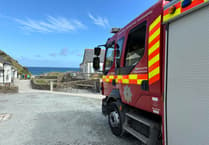PA23/06240: An application for listed building consent for the creation of a new stud wall enclosing a previously approved kitchenette with a fire shutter, alternative paint colour to existing timber windows and drill holes through stonework for electrical wires has been submitted for a historic property in Bodmin.
Ms Tash Arnold has applied to the local authority for permission to do the works at the Silvanus Trevail designed former Passmore Edwards library building in Bodmin, known as ‘The Old Library’, at 10 Fore Street, Bodmin, PL31 2JX.
Historic England said it did not need to add a comment to the application, saying: “Thank you for your letter of 17 August 2023 regarding the above application. On the basis of the information available to date, in our view you do not need to notify us of this application under the relevant statutory provisions, details of which are below.
“If you consider that this application does fall within one of the relevant categories, or you have other reasons for seeking our advice, please contact us to discuss your request.”
In the documents accompanying the listed building permission application, the building, which was Grade II listed on January 7, 1994, is listed as: “Institute and library. 1895. By Silvanus Trevail. For benefactor Passmore Edwards.
“MATERIALS: coursed squared local rubble with rock-faced granite plinth, otherwise freestone dressings including doorway and mullioned windows; mid-floor and 1st-floor sill strings and gable copings; dry slate roofs with shaped gables, crested clay ridge tiles. PLAN: irregular rectangular plan. Gothic style with Dutch Renaissance features.
“EXTERIOR: 2 storeys plus attic; symmetrical 1:1:1-bay road front. Central recessed entrance bay flanked by 2 cross wings with shaped gables. 2-light window with balcony balustrade on machicolations over round-arched doorway with vertical-glazed fanlight and panelled doors; flanking bays with paired chamfered attic lights with scrolled heads, over 3-light 1st-floor transomed windows with segmental-arched pediments; ground-floor windows with 4 lights over 2 lights.
“INTERIOR: original features include round arches to crossing vestibule, moulded ceiling cornices and open-well staircase with open string and turned balusters. HISTORY: Bodmin is one of 11 libraries and institutes donated by John Passmore Edwards to his county of birth.
“The seedgerm of this great man’s philanthropy was possibly created by a traumatic experience he had at Bodmin, when, “as a young office boy in Truro he walked to Bodmin and back, twenty miles each way, to witness the public hanging of two murderers”.
“Later in life he devoted much energy to denouncing capital punishment and fighting for its abolition. Silvanus Trevail (1851-1903) designed 6 buildings for John Passmore Edwards in Cornwall. He was a prolific architect who, apart from other buildings, designed 36 schools in Cornwall and eventually became President of the RIBA in 1901. (Best R S: The Life and Good Works of John Passmore Edwards: Redruth: 1981-: 12, 45).”
The application further described the conservation philosophy for the building as thus: “This is a prominent building within the centre of Bodmin and is one of the Free Library’s by Passmore Edwards who was involved with a number of public buildings including Free Library’s in London and Cornwall (where he was born), with his desire to provide books for the people.
“The style of the Free Libraries within Cornwall is distinctive and it is the desire to retain the character of this building and where possible reinstate some of the original features where reference to them can be found or some of the detail remains to be replicated.
“Where there is no reference to what the original features were (such as the windows, discussed in more detail in the document) then it is felt that rather than making assumptions and trying to revert to something that could have been there, reference is taken from what is currently built.
“This method is an honest approach to the conservation of the building and shows the development and patination of the building and it’s interventions that are now part of it. This is in line with the SPAB manifesto.”
It proceeded to detail the works planned for the building, namely: “The windows are in a poor condition with the paint failing to all of them and all require redecoration. It is the clients desire to use a gunmetal grey paint colour rather than white.
“After closer inspection it is clear that the larger sections of the windows are a more modern intervention with a mastic seal around the glazing rather than a more traditional putty. It is felt that the significance of the windows is the stonework surrounds, the opening top hung casements that still have putty and are a more historic detail, and WF05, WF11 & WF12 which are all leaded lights.
“Therefore, redecorating the windows in a gunmetal grey rather than white is not a detrimental impact to the significant aspects of the windows. It is also something that is reversable should the desire be there to return to white. It is also felt that this shows the patination of the building and the design of the refurbishment.”
The condition of the windows were noted and described as the following: “The majority of the windows on the North and West elevations do not appear to be original (except WF05 with the leaded lights) and are timber windows with large panes of single glazing, most of which are rotten (see fig. 19 on the next page) and not functioning as they should.
“Research has been carried out on the windows to try and establish if the leaded lights to WF05 are the original style windows as we believe, this style of window can also be seen in WF12 & WF13 above the stairs.
“It has not been possible to confirm this with absolute certainty from the drawings and images found in the Kresen Kernow archive (as shown earlier in the document).
“A sketch which can be seen on the next page (and cover page) suggests the windows were smaller panes as can be seen on other Passmore Edwards Free Libraries in Cornwall of this time. However, this is by no means a definitive conclusion that these were of that style, it is our assumption based on the information that is available.
“It should also be noted that the current windows show the patination of the building, and where the leaded lights are still insitu we are proposing to retain them with a slim profile secondary glazing system (Selectaglaze) to improve the thermal efficiency of the building.
“Therefore, it is proposed (in line with the conservation philosophy) to retain the style of windows that are currently within the North and West elevations and install new hardwood timber windows.
“It is the intention to use double glazing within these windows as the single glazing provides little to no thermal properties and by doing so this will hugely improve the thermal efficiency of the building and act as a starting point to improve its sustainability.
“The proposal is to use the slim historic double glazing so it’s visual impact is reduced.”
“The plans would also entail the installation of a first-floor kitchenette, described as thus: “This is to provide first floor office tenants with a small space to make tea and coffee without the need to go down and use the cafe everytime.
“There is currently one small area in one of the offices, but this is not accessible to all. The proposed location can be seen on the drawings and is to go on the first floor where the existing WC door is to be built up. It is felt this would not be damaging to the buildings historic fabric as the plumbing is also already in that location and there are no historic features to that wall.”
PA23/05706: Advertisement consent for a wall-mounted, externally illuminated aluminium composite sign featuring Wildanet text and logo to be fixed to the east elevation of Westbourne House in Liskeard has been granted.
It is subject to seven conditions, mostly related to the condition and maintenance of the signage, but also includes the following:
“No advertisement shall be sited or displayed so as to - a) endanger persons using any highway, railway, waterway, dock, harbour or aerodrome (civil or military), b) obscure, or hinder the ready interpretation of, any traffic sign, railway signal or aid to navigation by water or air, or c) hinder the operation of any device used for the purpose of security or surveillance or for measuring the speed of any vehicle.





Comments
This article has no comments yet. Be the first to leave a comment.